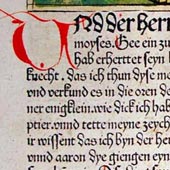Cabinet 01: The Decorated Initial

Decorative initials in illuminated manuscripts functioned as a form of basic punctuation. They marked significant sections or divisions within the text using a "hierarchy of initials" (Watson). Major initials were decorated with ornate embellishments or pictorial images (historiated) and could be several lines taller than the rest of the text. Minor initials were typically coloured letters, often with flourishing detail, and sometimes with a gold background.
The Grandes Heures, a book of hours, was commissioned by the Duke of Berry in 1407 and was finished in 1409. It contains three types of initials:
- The smallest, those the height of one line, mark the beginning of a phrase. Their style was popular in Paris at the end of the 13th century.
- Historiated initials, two lines high marking subdivisions and decorated with emblems of the Duke of Berry.
- Historiated initials, three lines high identifying major divisions and decorated with scenes.
All three types of initials can be seen in the pages on display.
Catholic Church, The Grandes Heures of Jean, Duke of Berry. New York, G. Braziller [1971]. Central ND3363.B5 GR15

Preparing coloured ink used in illuminated manuscripts was the task of an illuminator’s apprentice (Watson). Colours were obtained primarily from minerals and plants (Anderson), for example:
| Red | red ochre and plants including whortleberries |
| Blue | Azurite, a copper carbonate, and plants including indigo and woad |
| Bright blue | Lapis lazuli - a stone, as valuable as gold, found in Afghanistan |
| Green | The mineral malachite and verdigris formed on copper, brass and bronze |
| Yellow | Saffron |
| White | Lead oxide, chalk |
Colours were generally ground into a powder, dissolved in water and "mixed with a tempera medium, such as egg white or gum" (Anderson). Gold leaf was applied to the parchment before any colours and gold paint was applied after colouring.
Regardless of how colourful they are, texts are only technically "illuminated" if gold or silver is included in their decoration (Christopher de Hamel). By this definition, the coloured leaf from a printed Nuremberg Bible (1483) on display is not illuminated. Its decorated initial, a large red uncial letter U, is a traditional variant of a minor initial.
[One leaf from the Nuremberg Bible]. [Nuremberg, 1483]. DeBeer Ge 1483 B

Much of the Book of Kells history is uncertain, including who commissioned it. It is thought to have been stolen in 1007 from the church of Kells, buried then recovered (Walther). It is currently held at the Trinity College Library in Dublin. The Book of Kells was probably produced around 800 on the Island of Iona. It contains four Gospels, written in Latin, and is heavily ornate with 678 pages decorated with miniatures, initials and symbols. It was written on vellum (calf skin) and required 150 skins to complete the work (Walther). The initials, both major and minor, show Celtic style of decoration.The Book of Kells is an example of 'insular' art.

